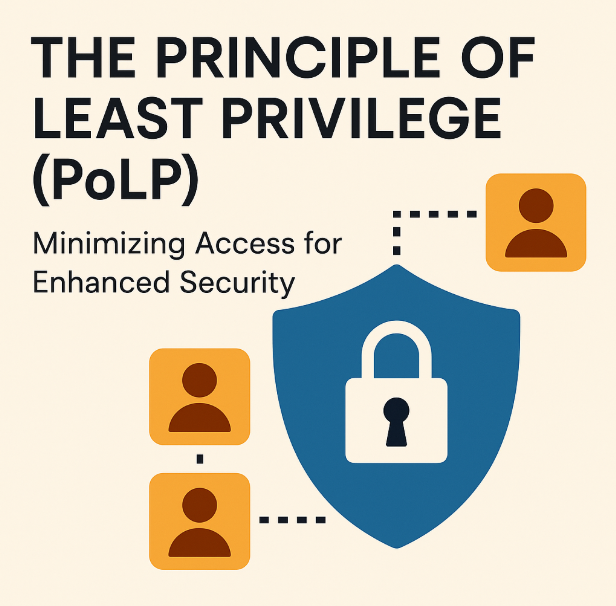The Principle of Least Privilege (PoLP): A Core Strategy for Cybersecurity in 2025
Understanding PoLP with Simple Examples — How Minimizing Access Strengthens Business Security and Builds Compliance
9/27/20253 min read


The Principle of Least Privilege (PoLP): Why It’s the Backbone of Modern Cybersecurity
In today’s digital-first world, small and large businesses are equally vulnerable to cyberattacks. While advanced tools like firewalls, intrusion detection systems, and encryption are critical, the Principle of Least Privilege (PoLP) is one of the simplest yet most powerful defenses. Just like the CIA Triad (Confidentiality, Integrity, Availability), PoLP forms the backbone of modern cybersecurity.
This blog will break down PoLP in simple, non-technical language with examples anyone can relate to, while also giving you SEO-rich, practical insights that will help businesses strengthen their security.
🔑 What is the Principle of Least Privilege?
The Principle of Least Privilege (PoLP) means giving any user, application, or process only the minimum access needed to perform their specific job — and nothing beyond that.
👉 Think of it like a house:
The chef should only enter the kitchen, not your bedroom.
The electrician should access the power supply, not your personal safe.
The delivery guy should only hand over the package at the door, not roam inside your home.
Similarly, in businesses:
A cashier can access the billing software but not employee salaries.
A marketing intern may need access to social media accounts, but not the finance dashboard.
A doctor can view patient health records, but not hospital accounting details.
This approach keeps things secure by ensuring no one has more power than they really need.
🛡️ Why is PoLP Important?
Minimizes the Attack Surface
Hackers often break into accounts. If every account has unlimited access, the entire system collapses. With PoLP, even if one account is hacked, damage is limited.Prevents Insider Threats
Not all threats come from outside. Sometimes employees (intentionally or by mistake) can leak or misuse data. Least Privilege reduces that risk.Helps with Compliance
Regulations like GDPR, HIPAA, and ISO 27001 require strict access controls. PoLP ensures your company stays compliant.Protects Against Human Errors
If too many employees have access, there’s a higher chance of accidental deletion or system misconfiguration. PoLP reduces such mistakes.
📌 Real-Life Examples
Hospital: Doctors see patient records, but accountants only manage billing. If a doctor’s login is hacked, the attacker can’t access financial systems.
Bank: A cashier can process deposits and withdrawals but cannot access loan approval systems.
Small Business: A marketing team member can run social media ads but shouldn’t have access to payroll software.
Each example proves: The less unnecessary access, the safer the business.
🛠️ How to Implement PoLP in Your Business
Role-Based Access Control (RBAC): Give access based on roles (doctor, accountant, marketer) instead of individuals.
Just-in-Time Access: Temporary access for specific tasks, then remove it.
Regular Access Reviews: Audit access every month. Remove users who no longer need certain permissions.
Multi-Factor Authentication (MFA): Add an extra layer of login security.
Identity & Access Management (IAM) Tools: Automate privilege assignments and monitoring.
🚀 Benefits for Businesses
Reduced Risk: Limited access means less damage during breaches.
Compliance Ready: Easier alignment with laws and audits.
Higher Trust: Customers trust businesses that take data seriously.
Operational Stability: Fewer mistakes from employees having too much access.
🌍 Why PoLP Matters in 2025 and Beyond
With remote work, cloud services, and third-party integrations increasing, businesses have more entry points than ever before. Cybercriminals target the weakest link — often an over-privileged employee account.
By applying PoLP as a standard practice, companies can:
Stay secure in an evolving digital world.
Reduce risk of insider and outsider attacks.
Safeguard brand reputation and customer trust.
❓ Frequently Asked Questions (FAQs)
Q1: Is PoLP only for large enterprises?
No. Small businesses are often easier targets. Implementing PoLP is equally important for them.
Q2: Will PoLP slow down employees?
Initially, some may feel restricted. But in reality, it makes systems faster and safer by reducing unnecessary clutter.
Q3: Can PoLP stop all cyberattacks?
No system is 100% safe, but PoLP drastically reduces the damage attackers can cause.
Q4: How often should access rights be reviewed?
At least once every quarter, or immediately after an employee leaves or changes role.
✅ Key Takeaway
The Principle of Least Privilege (PoLP) is a simple yet powerful cybersecurity strategy. By giving users and applications only the access they truly need, businesses can minimize risks, reduce errors, and stay compliant.
In short: Less access = More security.
✍️ Written by Our Secure Universe Pvt Ltd — simplifying cybersecurity for businesses worldwide with practical, easy-to-understand solutions.